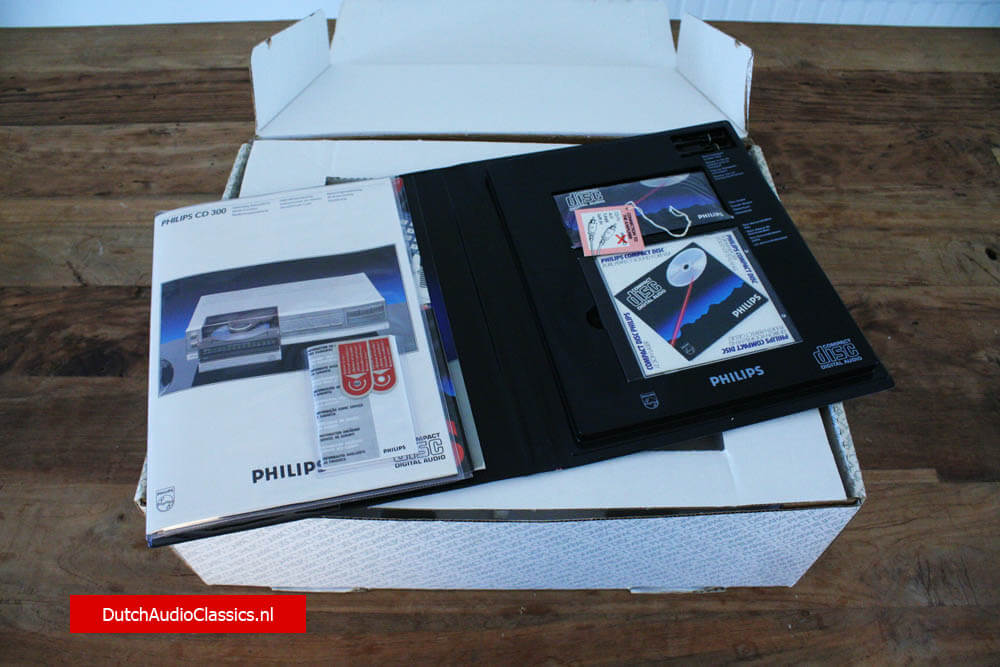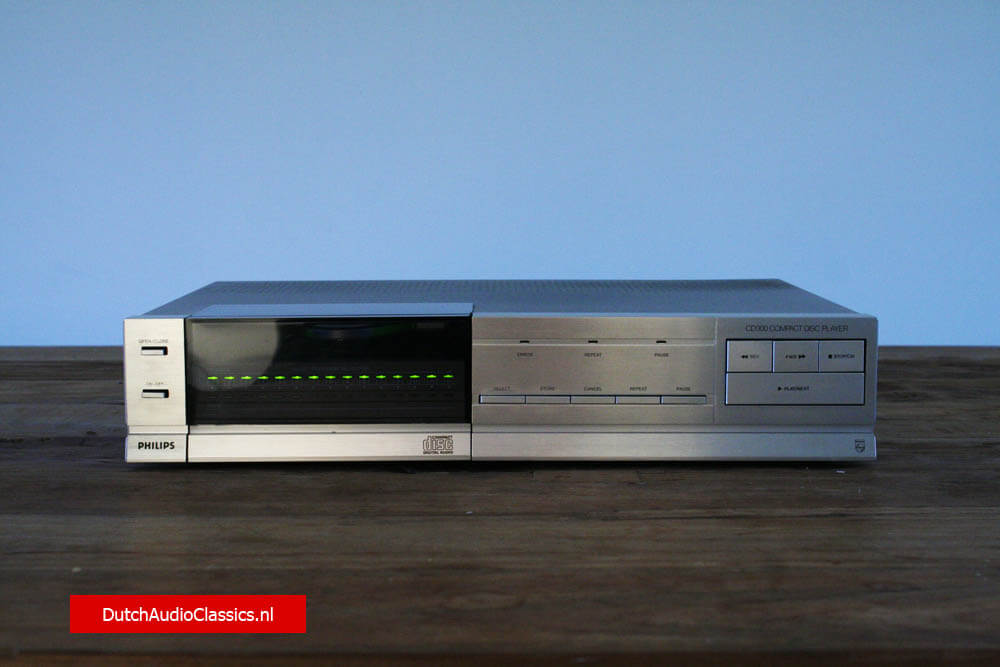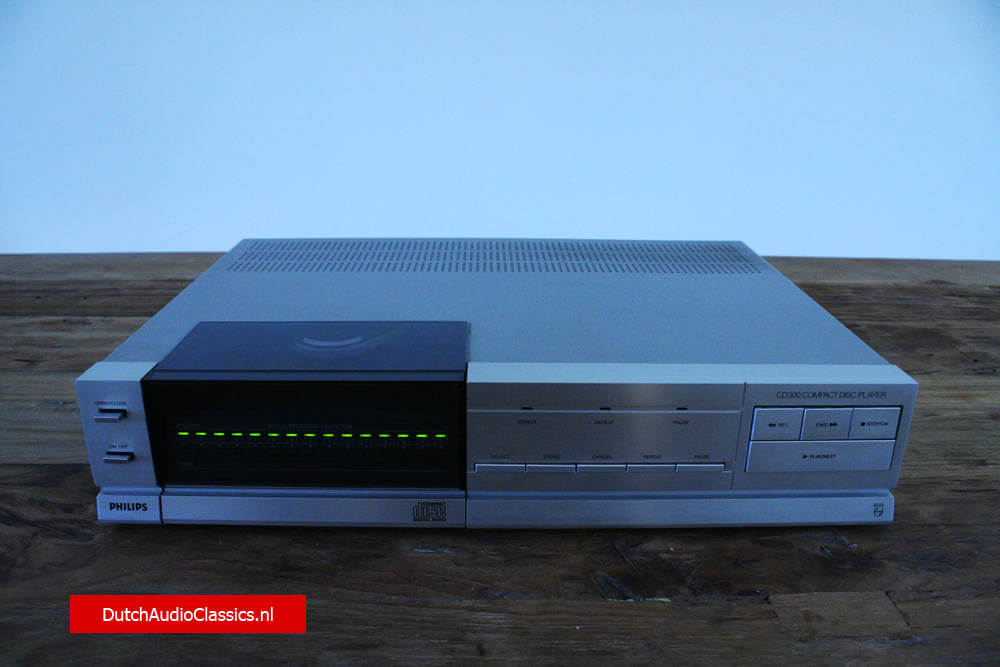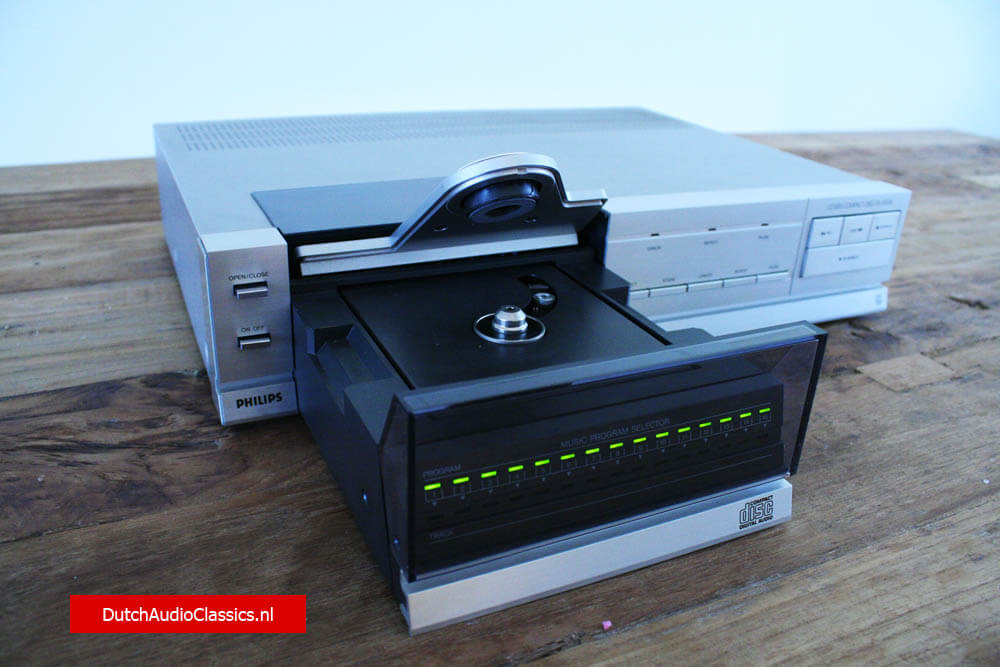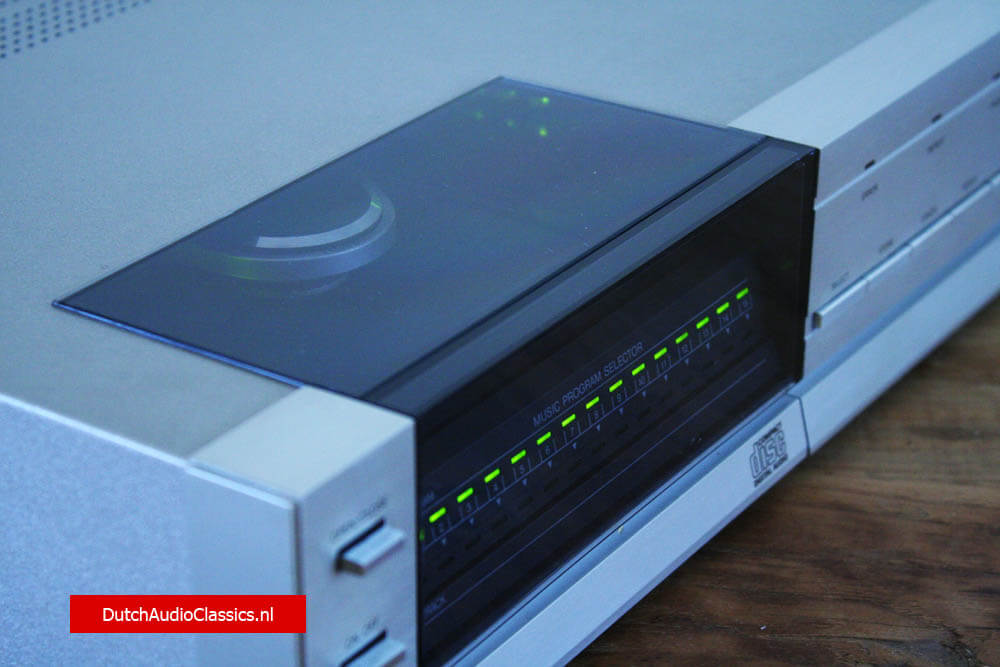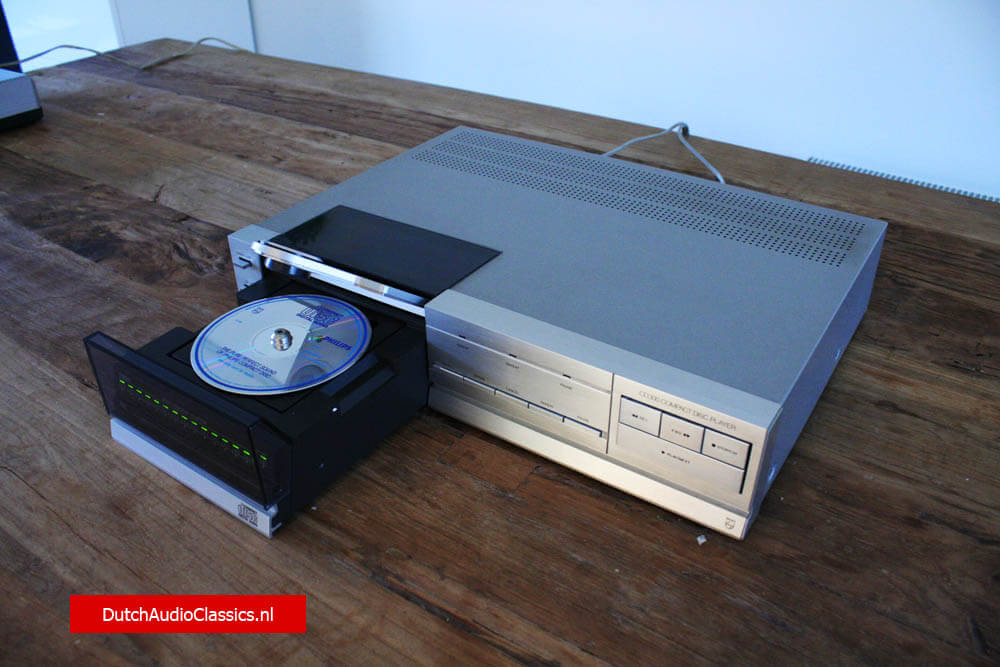The Philips CD300, the third Compact Disc player in the Philips range, provides conclusive proof of Philips enormous lead in Compact Disc technology.
Philips CD300

Just 88mm high and 420mm wide, the beautiful slim-line machine fits perfectly in or on top of a standard HiFi rack. The motorised front drawer makes loading and removing discs from the player absolutely effortless. And again, the controls are well laid out for simple, straightformward, operation of the Philips CD300's versatile features.
The Philips CD300 features pre-programming capacity for up to 15 tracks inany sequence. The programmed tracks are indicated by LED's which extinguish once the track has been played. Play, next track, location of any point on a track - forwards or backwards, fast search, pause and repeat are all featured and all operated by single push button controls.

The Philips CD300 connects to you HiFi amplifier in exactly the same wat as the PHilips CD100 and Philips CD200 and comes complete with the same detailed information, demonstration disc and cleaning duster
Philips CD300 specifications
- Audio performance: 20Hz - 20kHz
- Frequency response: +/- 0.3dB
- Phase linearity: +/1 0.5º
- Signal-to-noise ratio: > 90dB
- Channel separation: > 90dB (at 1kHz)
- T.H.D. (incl. noise): < 0.004% (at 1kHz)
- Intermodulation distortion measured at max. output level: < -86dB
- Out-band rejection (frequencies > 24kHz): > 50dB
- Wow & flutter: Quartz Crystal Precision
- Max. output level (at MSB): 2V rms, typical
- Min. load impedance: 10 kΩ
- Power consumption: 30W approx
- Dimensions (wxhxd): 420mm x 86mm x 300mm
- Weight: 8kg approx.
The Compact Disc Users Pack
Each Philips Compact Disc player comes with a fully complete Users Pack. Besides the operating instructions, the Users Pack has been designed to help the Philips Compact Disc owner gain the full benefit of his purchase.
A free disc is included featuring 14 different tracks which fully illustrate the sound quality and capability of the Philips range of Compact Disc players.
In addition, there are two full colour brochures which provide detailed information about laser and digital technologies and how they are used to full effect in Philips Compact Disc. A catalogue of disc titles is included with the option of joining the Philips CD Club. Membership of the Philips CD Club entitles the CD owner to receive free of charge, the latest catalogue of disc titles and other interesting material relating to Compact Disc.
The users pack also include instruction for use in 10 languages and a cleaning duster. The users pack is also intended to be kept by the user to house the cdplayers documentation and transport screws.
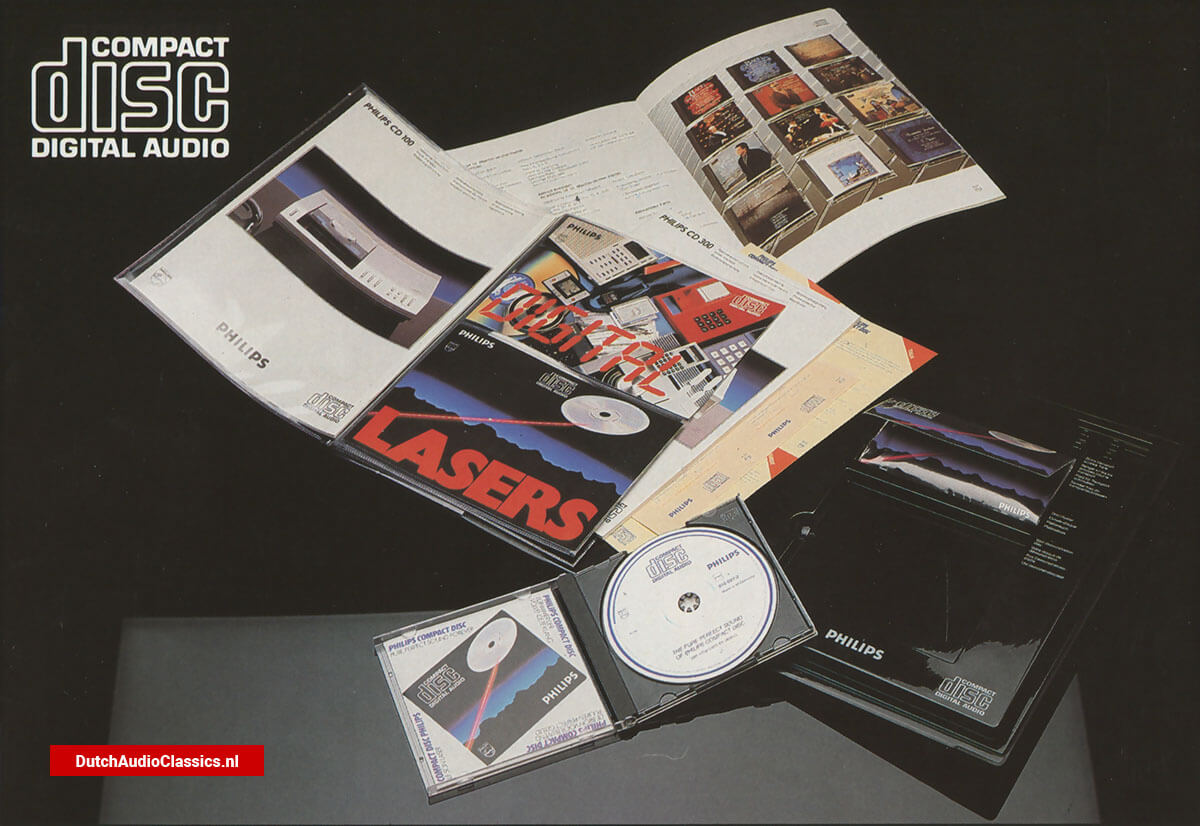 The Philips CD users pack
The Philips CD users pack
CD decoding
The signal picked up by the photodetector is a frame struc-tured data stream containing a great deal of information in EFM (eight-to-fourteen modulation) format. The first stage of decod-ing is to establish clocking (timing), and to retrieve the 8-bit format from the EFM format. For this purpose, the syn-chronisation pattern is separated from the control and display symbol and the (audio) data symbols. Clocking will eliminate small timing errors (jitter) in the data stream, caused e.g. by disc speed variations. The second stage of decoding is application of error correction and interpolation to the data symbols.
In the third stage, left and right channel data words are demultiplexed (split apart) and separately converted back to analogue for to provide normal-style stereo pre-amplifier input signals. Meanwhile, the derived clocking signal is compared with a quartz crystal controlled oscil-lator reference frequency. Any discrepancy generates an imme-diate correction signal for the disc motor speed servo system. This servo system, together with the abovementioned clocking operation of the data stream, is making wow and flutter com-pletely inaudible.
 The CD decoding circuitry
The CD decoding circuitry
It can be seen that before the signal is returned to its analogue state, it is subjected to consider-ableprocessing in the digital condition. Digital processing is entirely a switching operation, with the necessary timing and synchronisation. For the Com-pact Disc player, with 588 chan-nel bits per frame and a data stream bit rate of well over four million bits per second, thou-sands of instantaneous switch-ing circuits are needed. Only with the development in the last few years, of large scale inte-grated circuits (LSI's), has it become possible to produce such circuitry within the small dimensions and economics necessary to make Compact Disc Digital Audio a practical proposition.
The optical readout
Apart from digitalisation, Compact Disc Digital Audio introduces another very significant innovation — optical read-out using a laser beam. In essence, a laser is a source of highly concentrated light which can be very sharply focused. The word 'Laser', in fact, stands for Light Amplification by Stimulated Emission of Radiation, and because of the precise nature of the beam, the laser princ¬iple has already found many applications in science and industry.
The Compact Disc laser, a small, low-power semi-conductor (aluminium gallium arsenide) unit, emits invisible infra-red light.
 The CD Laser Beam Pick-up: one milliwatt of power is all that is needed by the tiny light beam. Yet it reads every last detail of the digital information on the disc.
The CD Laser Beam Pick-up: one milliwatt of power is all that is needed by the tiny light beam. Yet it reads every last detail of the digital information on the disc.
The Compact Disc optical read-out system achieves a read-out accuracy, from an extremely high-density digital recording, that no mechanical system could ever hope to attain.
Dust particles and scratches sit on the disc surface, out of the focus of the laser beam. Because the beam is highly convergent, most particles and scratches are small in relation to the spot diameter
Philips CD Optical Readout System
The beam from the laser is reflected by a special semi-reflecting mirror to the lens system, which keeps it in sharp focus on the recording in the Compact Disc. Beam reflections returning through the lens system pass straight through the semi-reflecting mirror, and on to the photo-detector.
An optical system concentrates the laser beam to a spot less than 1 micron (pm) in diameter, capable of reading the densely packed recording in the Compact Disc. This recording consists of a contin¬uous track of pits in a brightly reflective surface. The pits are microscopic - only 0.5 pm wide, 0.1 pm deep and 1 to 3 pm long, at a track pitch of 1.6 pm.
As the disc rotates, the laser scans the pit pattern. When the beam falls on a flat surface, it is reflected. The optical system guides the reflected beam to an array of photodiodes. When the beam falls into a pit, it is scattered. Very little light finds its way through to the photo-diode array. The flats and pits on the recorded track are thus read as 'on' and 'off' impulses by the photodiode array. The sequence of impulses forms the data stream of channel bits for the player electronics.
The beam reads the recording from the inside to the outside of the disc. A servo system holds the spot in focus on the recording surface, compensating for disc warp or any other unevenness in disc rotation. A second servo compensates for eccentricity and holds the beam on the track. This tracking servo is also used to move the beam across tracks, to gain fast access to any part of the recording, and to create pauses in the music.
Tracking and Focusing: choosing the best method
Player performance depends heavily on effective tracking and focusing. Eccentricity may swing the rotating disc up to 300 pm from side to side, but the spot should follow the centre of the track within 0.1 pm. Disc warp may be as much as 1 mm, but the spot should focus on the track within 0.5 pm. The spot should also stay in position in spite of shock, vibration or dropouts. But it needs to cross tracks quickly for track skip or music search. These are tough require¬ments. But the Philips CMD 2 Laser Assembly, with its control servos, meets them all.
Single-spot or 3-spot Beam?
A single-spot beam can be mounted on a pivoted arm or a linear tracking sledge. Philips use a pivoted arm, which moves very fast for track access, and is highly sensitive to tracking corrections.
The traditional disadvantages of the pivoted arm do not apply to a laser beam pick-up, with its electronic servos. A 3-spot beam must be mounted on a linear tracking sledge, which may compromise the fast access and tracking sensitivity. At the same time, the secondary spots are vulnerable to inter¬ference from adjacent tracks, which can affect tracking and focusing.
For tracking, Philips players use a single-spot laser on a low-inertia pivoted arm, in preference to a 3-spot laser on a linear tracking sledge. The pivoted arm, with linear magnetic drive, moves faster (less than a second from inner to outer track). It follows large ecce.itricities easily, withstands bumps well, and, with only one moving part, is reliable and long-wearing. Mechanically isolated by fully floating suspension, it is practically immune to shock and vibration.
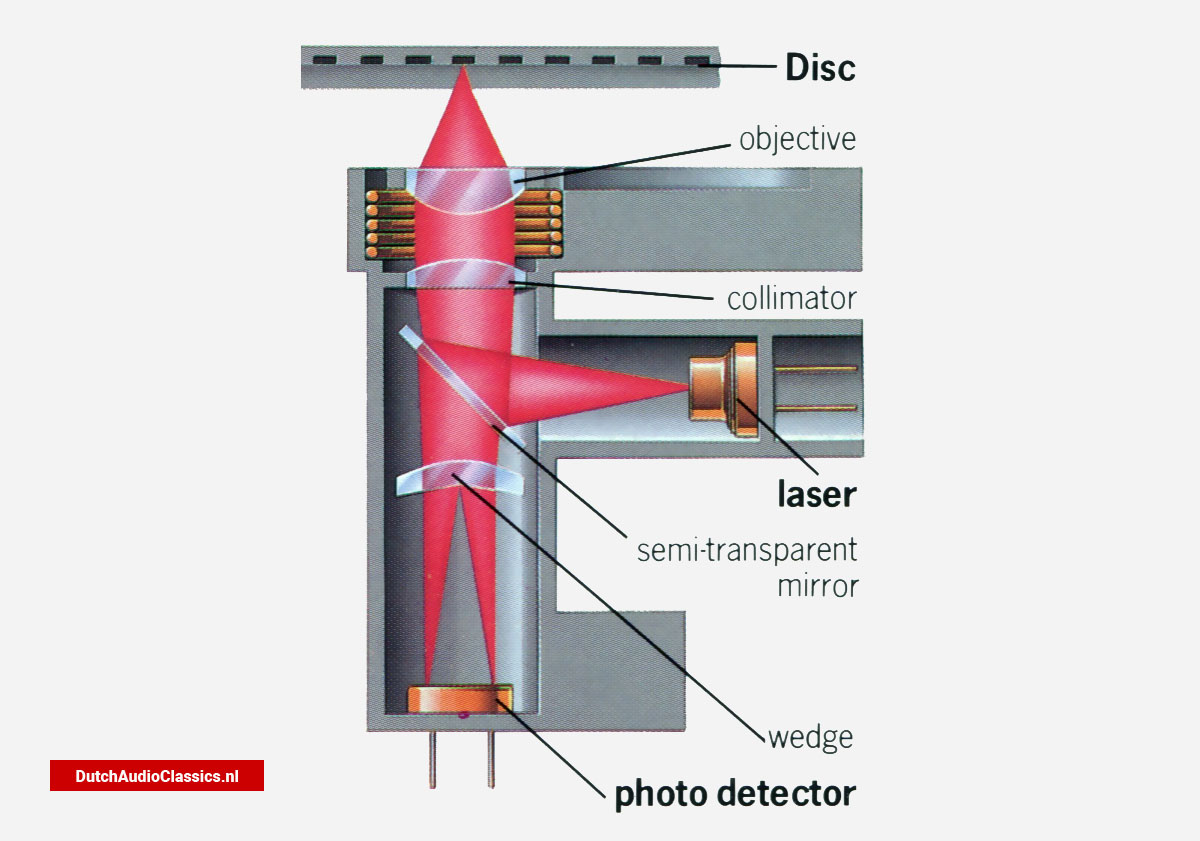 The beam from the laser passes straight through a special semi-reflecting prism and on to the lens system, which keeps it in sharp focus on the recording in the Compact Disc. Beam reflections return through the lens system to the semi-reflecting prism, where they are diverted away from the laser and into the photo-detector.
The beam from the laser passes straight through a special semi-reflecting prism and on to the lens system, which keeps it in sharp focus on the recording in the Compact Disc. Beam reflections return through the lens system to the semi-reflecting prism, where they are diverted away from the laser and into the photo-detector.
Because the read-out is optical, the 'pick-up' causes no more wear to the recording than reading causes to the words printed on this page. In fact, the reflective track surface is covered with a transparent plastic seal, which affords permanent protection. The very high opening angle of the objective lens keeps surface scratches, dust and dirt well out of focus, and only really large marks are detected by the photo diodes. Even then, the CIRC error correction system increas¬es the capability to cope with severe optical distortion arising from dirt or damage.
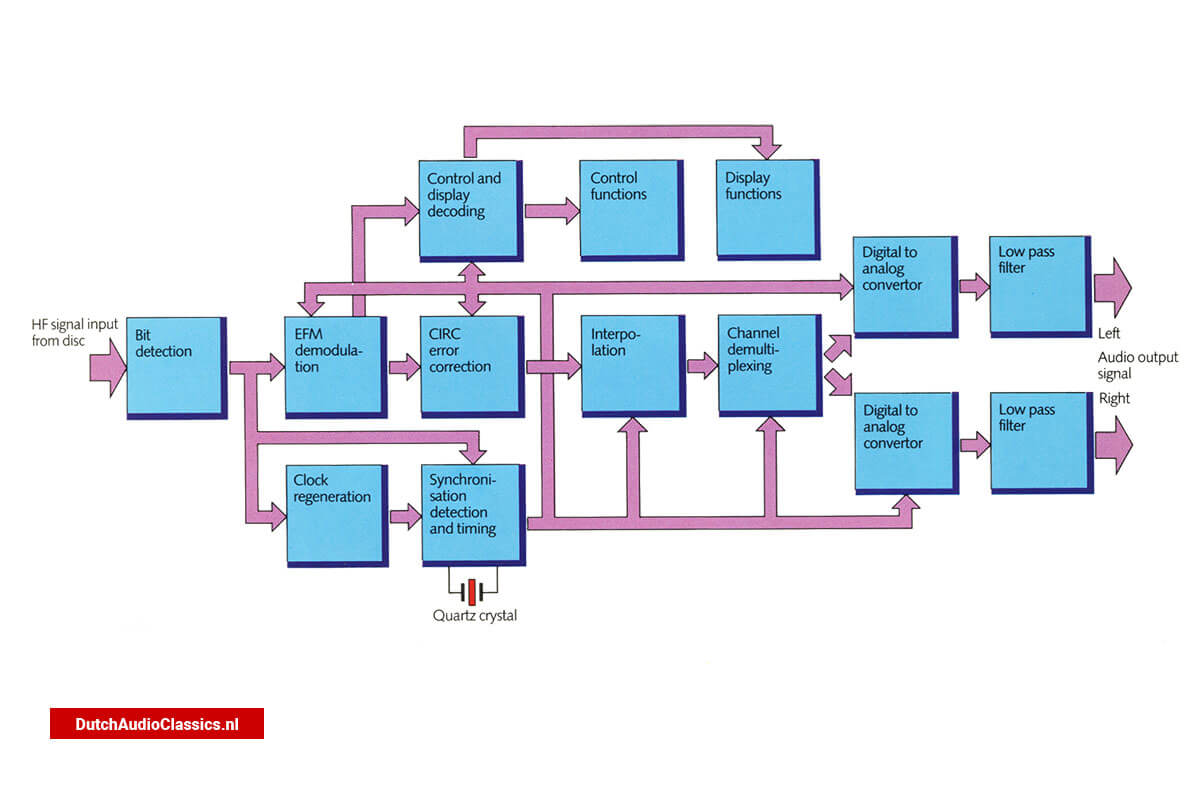 The decoding diagram
The decoding diagram














